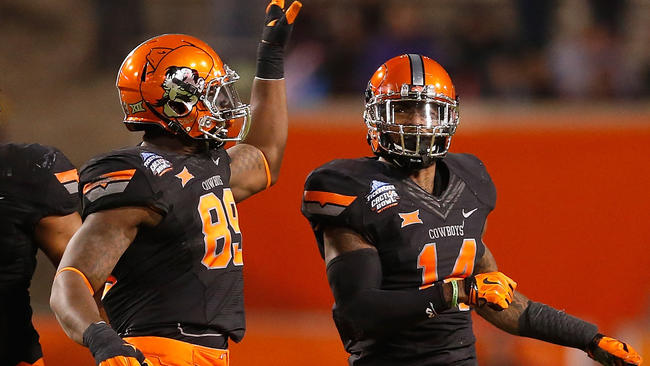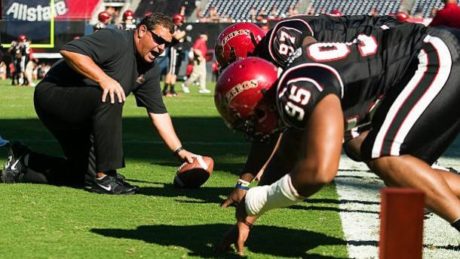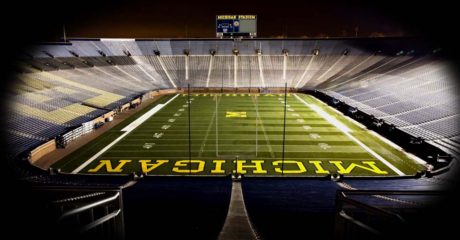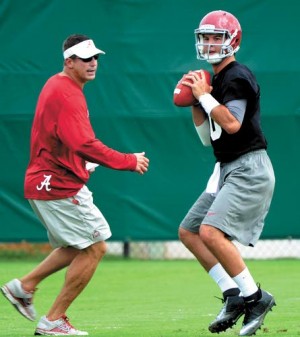 |
| Josh Furman (right) became a seventh round draft pick at Oklahoma State |
Thanks to David for the recent donation! If you would also like to donate to the site redesign drive, please use Paypal (on the left sidebar) or do some shopping on Amazon (LINK). Thanks!
—————
The NFL Draft is over and guys are signing undrafted free agent contracts, so it’s time for another ex-Wolverine update. I’m also including the fates of a few coaches, in case you’re wondering what some of those guys up to these days.
Former offensive coordinator Al Borges: Borges has been hired as San Jose State’s offensive coordinator (LINK). He joins former Michigan defensive coordinator Greg Robinson, who is SJSU’s defensive coordinator.
Former offensive line coach Darrell Funk: Funk has been hired as Akron’s offensive line coach (LINK).
Former safety Josh Furman: Furman, who spent his fifth year senior season playing linebacker at Oklahoma State, was drafted in the seventh round by the Denver Broncos (LINK).
Hit the jump for more ex-Wolverines, including a list of the fates of all 27 players from the 2010 class.
Former offensive coordinator Doug Nussmeier: Nussmeier is first-year coach Jim McElwain’s offensive coordinator and quarterbacks coach at Florida (LINK).
Former running back Thomas Rawls: Rawls, who transferred to Central Michigan for his senior year, signed an undrafted free agent contract with the Seattle Seahawks (LINK).
Former linebackers/defensive line coach Mark Smith: Smith has been hired as Florida Tech’s defensive line coach (LINK).
Former safety Ray Vinopal: After spending his final four years at Pitt, Vinopal signed an undrafted free agent deal with the Dallas Cowboys (LINK).
Remember the monster 2010 recruiting class that saw the Wolverines sign 27 players? It has become notorious for how little was produced at Michigan, since the vast majority of players failed to qualify, quit, or transferred early in their careers. There are still some years left for them to prove themselves through pro tryouts and such, but with the NFL Draft completed and guys signing free agent contracts, here’s where things stand:
Richard Ash, DT: Played his fifth year at Western Michigan. Undrafted.
Courtney Avery, CB: Played four years at Michigan. Undrafted.
Jibreel Black, DE: Played four years at Michigan. Undrafted.
Cullen Christian, CB: Played one year at Michigan, three at Pitt, one at West Virginia. Undrafted.
Drew Dileo, WR: Played four years at Michigan. Undrafted.
Demar Dorsey, S: Did not qualify. Played at junior college.
Josh Furman, S: Played fifth year at Oklahoma State. Drafted in 7th round by Broncos.
Devin Gardner, QB: Played five years at Michigan. Signed as undrafted free agent by Patriots.
Will Hagerup, P: Played five years at Michigan. Undrafted.
Stephen Hopkins, RB: Played three years at Michigan. Quit football.
Jeremy Jackson, WR: Played four years at Michigan. Undrafted.
Carvin Johnson, S: Played one year at Michigan, three at Hampton. Undrafted.
Conelius Jones, QB/DB: Did not qualify.
Antonio Kinard, LB: Has not qualified. Played at junior college.
Ricardo Miller, WR: Played three years at Michigan, one year at UMass. Undrafted.
Christian Pace, C: Career ended early due to injury.
Jordan Paskorz, DE: Played four years at Michigan. Undrafted.
Jerald Robinson, WR: Played two years at Michigan, one in D-II. Undrafted.
Marvin Robinson, S: Played three years at Michigan, one in D-II. Signed as UDFA with Cowboys in 2014 but was released.
Davion Rogers, LB: Did not qualify. Played one season at Youngstown State. Undrafted.
Jake Ryan, LB: Played five years at Michigan. Drafted in 4th round by Packers.
Terrence Talbott, CB: Played two years at Michigan. Quit football.
Terry Talbott, DT: Played two years at Michigan. Quit football.
Ray Vinopal, S: Played one year at Michigan, four at Pitt. Signed as UDFA with Cowboys.
Austin White, RB: Played one year at Michigan, transferred to Central Michigan, got in legal trouble. Quit football.
Ken Wilkins, DE: Played four years at Michigan, one in D-II. Undrafted.
Adrian Witty, CB: Did not qualify immediately and signed with Cincinnati in 2011. Played four years at Cincinnati with a fifth coming up in 2015.
D.J. Williamson, WR: Played one year at Michigan. Quit football.
TOTALS
DNQ: (Dorsey, Jones, Kinard, Rogers, Witty) = 5
Quit or kicked off team: (Hopkins, Talbott, Talbott, White, Williamson) = 5
Played out eligibility: (Avery, Black, Dileo, Gardner, Hagerup, Jackson, Ryan) = 7
Left early for draft: 0
Transferred to other FBS schools: (Ash, Christian, Furman, Miller, Vinopal) = 5
Transferred to lower football divisions: 4 (Johnson, Robinson, Robinson, Wilkins) = 4
Career ended due to injury: (Pace) = 1





